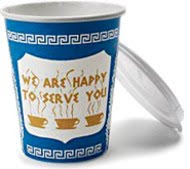It was for decades the most enduring piece of ephemera in New York City and is still among the most recognizable. Trim, blue and white, it fits neatly in the hand, sized so its contents can be downed in a New York minute. It is as vivid an emblem of the city as the Statue of Liberty, beloved of property masters who need to evoke Gotham at a glance in films and on television. It is, of course, the Anthora, the cardboard cup of Grecian design that has held New Yorkers’ coffee securely for nearly half a century. Introduced in the 1960s, the Anthora was long made by the hundreds of millions annually, nearly every cup destined for the New York area.
A pop-cultural totem, the Anthora has been enshrined in museums; its likeness has adorned tourist memorabilia like T-shirts and ceramic mugs. Like many once-celebrated artifacts, though, the cup may now be endangered, the victim of urban gentrification.
The Anthora seems to have been here forever, as if bestowed by the gods at the city’s creation. But in fact, it was created by man — one man in particular, a refugee from Nazi Europe named Leslie Buck. Mr. Buck, a retired paper-cup company executive, died on Monday, at 87, at his home on Long Island, in Glen Cove. The cause was complications of Parkinson’s disease, his son Robert said. Mr. Buck, previously a longtime resident of Syosset, N.Y., also had a home in Delray Beach, Fla.
Leslie Buck in 1991.
The Anthora has spawned a flock of imitations by competitors over the years, but it was first designed by Mr. Buck for the Sherri Cup Company in Kensington, Conn.
Mr. Buck’s cup was blue, with a white meander ringing the top and bottom; down each side was a drawing of the Greek vase known as an amphora. (“Anthora” comes from “amphora,” as filtered through Mr. Buck’s Eastern European accent, his son said.) Some later imitators depict fluted white columns; others show a discus thrower.
On front and back, Mr. Buck emblazoned the Anthora with three steaming golden coffee cups. Above them, in lettering that suggests a Classical inscription, was the Anthora’s very soul — the motto. It has appeared in many variant texts since then; Mr. Buck’s original, with its welcome intimations of tenderness, succor and humility, was simply this:
We Are Happy
To Serve You.
Though the Anthora no longer dominates the urban landscape as it once did, it can still be found at diners, delis and food carts citywide, a squat, stalwart island in a sea of tall, grande and venti. On the street, it warms the harried hands of pedestrians. Without the Anthora, “Law & Order” could scarcely exist.
Laszlo Büch was born on Sept. 20, 1922, to a Jewish family in Khust, then in Czechoslovakia. (It is today in Ukraine.) His parents were killed by the Nazis during World War II; Laszlo himself survived Auschwitz and Buchenwald.
After the war, Mr. Buck made his way to New York, where he Americanized his name and ran an import-export business with his brother, Eugene, who had also survived the camps. In the late 1950s or thereabouts, the brothers started Premier Cup, a paper-cup manufacturer in Mount Vernon, N.Y.
Leslie Buck joined Sherri Cup, then a startup, in the mid-’60s. Originally the company’s sales manager (for a time, he was its entire sales force), he later became its director of marketing.
Sherri was keen to crack New York’s hot-cup market. Since many of the city’s diners were owned by Greeks, Mr. Buck hit on the idea of a Classical cup in the colors of the Greek flag. Though he had no formal training in art, he executed the design himself. It was an instant success.
Mr. Buck made no royalties from the cup, but he did so well in sales commissions that it hardly mattered, his son said. On his retirement from Sherri in 1992, the company presented Mr. Buck with 10,000 specially made Anthoras, printed with a testimonial inscription.
Besides his son, Robert, and brother, Eugene, Mr. Buck is survived by his wife, the former Ella Farkas, whom he married in 1949; two daughters, Beverly Eisenoff and Linda Rush; and four grandchildren.
In recent years, with the gentrification of the city and its brew, demand for the humble Anthora has waned. In 1994, Sherri sold 500 million of the cups, as The New York Times reported afterward. In 2005, the Solo Cup Company, into which Sherri had been absorbed, was selling about 200 million cups a year, The Times reported.
Today, Solo no longer carries the Anthora as a stock item, making it only on request. Other companies still turn out versions of the cup, though not in the quantities of its 20th-century heyday.
But given the tenacious traditionalism of many locals (“Avenue of the Americas,” anyone?), it is safe to assume that the Anthora and its heirs will endure, at least for a while, in the city’s steadfast precincts. For some time to come, on any given day, somewhere a New Yorker will be cradling the cup, with its crisp design and snug white lid, the stuff of life inside.
April 29, 2010
Leslie Buck, Designer of Iconic Coffee Cup, Dies at 87
By MARGALIT FOX


No comments:
Post a Comment